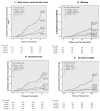Association of high-sensitivity cardiac troponin T with mortality and cardiovascular events in a community-based prospective study in Beijing
- PMID: 28652289
- PMCID: PMC5541394
- DOI: 10.1136/bmjopen-2016-013431
Association of high-sensitivity cardiac troponin T with mortality and cardiovascular events in a community-based prospective study in Beijing
Abstract
Objective: The prognostic value of cardiac troponins in apparently healthy populations is not well established. The aim of this study was to investigate the prognostic properties of high-sensitivity cardiac troponin T (hs-cTnT) for long-term adverse outcomes.
Setting: A community-dwelling prospective survey of residents from two communities in Beijing.
Participants: From September 2007 to January 2009, 1680 participants were initially enrolled. Of these, 1499 (870 females, mean age: 61.4 years) participants completed the survey and were followed up for a median of 4.8 years (IQR: 4.5-5.2).
Outcome measures: The primary outcome was the occurrence of all-cause mortality and major cardiovascular events.
Results: Overall, 820 individuals (54.7%) had detectable hs-cTnT levels. During the follow-up, 52 participants (3.5%) died, 154 (10.3%) had major cardiovascular events and 99 (6.6%) experienced new-onset coronary events. Compared with those with undetectable hs-cTnT levels, participants with hs-cTnT levels in the highest category (≥14 ng/L) had a significantly increased risk for all-cause mortality (adjusted HR (aHR): 2.07, 95% CI 1.05 to 3.01), major cardiovascular events (aHR: 3.27, 95% CI 1.88 to 5.70) and coronary events (aHR: 4.50, 95% CI 2.26 to 9.02) in covariate-adjusted analyses. No differences in stroke incidence were found (aHR: 1.27, 95% CI 0.69 to 2.62). Also, significant associations were presented when hs-cTnT levels were modelled as a continuous variable and when analysing changes in hs-cTnT levels over time with adverse outcomes. The addition of troponin T levels to clinical variables led to significant increases in risk prediction with a marked improvement in the C-statistics (p=0.003 or lower).
Conclusions: In this cohort of individuals from a community-based population, cTnT levels measured with a highly sensitive assay were associated with increases in the subsequent risk for all-cause mortality and major cardiovascular events. These results might support screening for at-risk individuals.
Keywords: biomarkers; cardiovascular diseases; high-sensitivity cardiac troponin T; prognosis; risk assessment..
© Article author(s) (or their employer(s) unless otherwise stated in the text of the article) 2017. All rights reserved. No commercial use is permitted unless otherwise expressly granted.
Conflict of interest statement
Competing interests: None declared.
Figures

Similar articles
-
High-sensitive troponin T is associated with all-cause and cardiovascular mortality in stable outpatients with type 2 diabetes (ZODIAC-37).Am Heart J. 2016 Apr;174:43-50. doi: 10.1016/j.ahj.2015.12.015. Epub 2015 Dec 31. Am Heart J. 2016. PMID: 26995369 Clinical Trial.
-
Association of serial measures of cardiac troponin T using a sensitive assay with incident heart failure and cardiovascular mortality in older adults.JAMA. 2010 Dec 8;304(22):2494-502. doi: 10.1001/jama.2010.1708. Epub 2010 Nov 15. JAMA. 2010. PMID: 21078811 Free PMC article.
-
Highly sensitive cardiac troponin T and long-term mortality in a population of community-derived perimenopausal women: nested case-control study.Heart. 2013 Apr;99(8):528-33. doi: 10.1136/heartjnl-2012-302829. Epub 2013 Jan 12. Heart. 2013. PMID: 23315610
-
Prognostic value of basal high-sensitive cardiac troponin levels on mortality in the general population: A meta-analysis.Medicine (Baltimore). 2016 Dec;95(52):e5703. doi: 10.1097/MD.0000000000005703. Medicine (Baltimore). 2016. PMID: 28033267 Free PMC article.
-
A systematic review and meta-analysis evaluating the association of high sensitivity troponin levels with outcomes in patients with stable coronary artery disease.Curr Med Res Opin. 2024 Oct;40(10):1685-1695. doi: 10.1080/03007995.2024.2401632. Epub 2024 Sep 18. Curr Med Res Opin. 2024. PMID: 39235073
Cited by
-
Circulating Ceramide: A New Cardiometabolic Biomarker in Patients With Comorbid Acute Coronary Syndrome and Type 2 Diabetes Mellitus.Front Physiol. 2020 Sep 15;11:1104. doi: 10.3389/fphys.2020.01104. eCollection 2020. Front Physiol. 2020. PMID: 33041846 Free PMC article.
-
A comparison of echocardiographic and circulating cardiac biomarkers for predicting incident cardiovascular disease.PLoS One. 2022 Jul 25;17(7):e0271835. doi: 10.1371/journal.pone.0271835. eCollection 2022. PLoS One. 2022. PMID: 35877671 Free PMC article.
-
Association between high-sensitivity cardiac troponin T levels and incident stroke in the elderly Japanese population: Results from the Tohoku Medical Megabank Community-based Cohort Study.Am Heart J Plus. 2022 Sep 28;22:100212. doi: 10.1016/j.ahjo.2022.100212. eCollection 2022 Oct. Am Heart J Plus. 2022. PMID: 38558906 Free PMC article.
-
High-sensitivity troponin and the risk of atrial fibrillation in chronic kidney disease: Results from the Chronic Renal Insufficiency Cohort Study.Heart Rhythm. 2020 Feb;17(2):190-194. doi: 10.1016/j.hrthm.2019.08.015. Epub 2019 Aug 14. Heart Rhythm. 2020. PMID: 31421237 Free PMC article.
-
The role of biomarkers in the diagnosis and risk stratification of acute coronary syndrome.Future Sci OA. 2017 Oct 27;4(1):FSO251. doi: 10.4155/fsoa-2017-0036. eCollection 2018 Jan. Future Sci OA. 2017. PMID: 29255623 Free PMC article. Review.
References
-
- Blankenberg S, Zeller T, Saarela O, et al. . Contribution of 30 biomarkers to 10-year cardiovascular risk estimation in 2 population cohorts: the MONICA, risk, genetics, archiving, and monograph (MORGAM) biomarker project. Circulation 2010;121:2388–97.10.1161/CIRCULATIONAHA.109.901413 - DOI - PubMed
Publication types
MeSH terms
Substances
Associated data
LinkOut - more resources
Full Text Sources
Other Literature Sources
Research Materials
Miscellaneous
